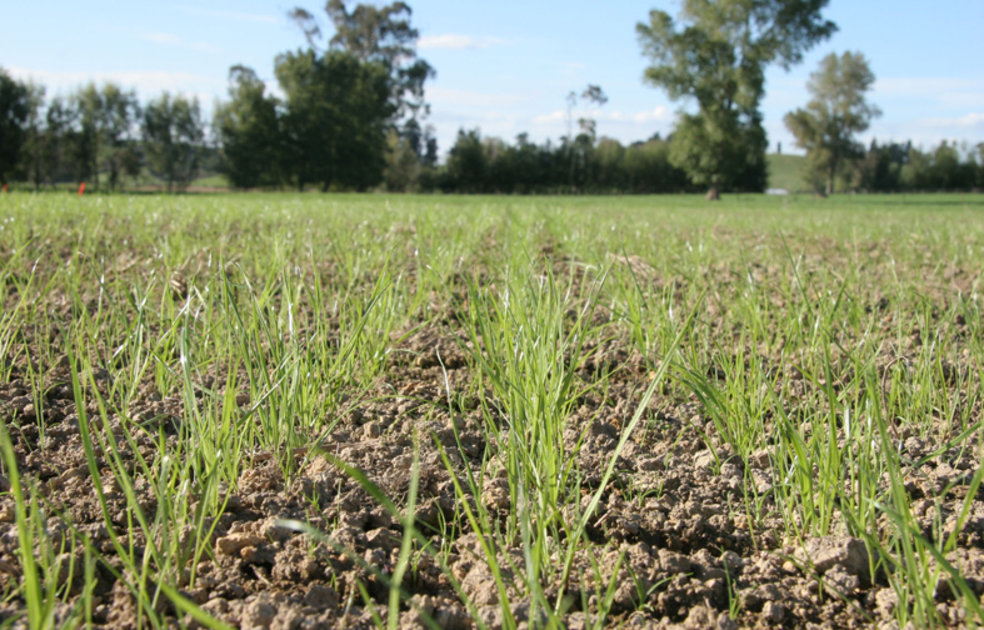The ABCs of new perennial pasture – think ‘crop’, not ‘grass’
Perennial ryegrass is the beating heart of our pastoral farm systems. Yet in many cases we still establish short term crops like maize with far more care and attention.
So this season it’s time to look at your newly sown pastures not as ‘grass’ but as a crop, one that will grow you 100 t/ha -plus of high quality DM and fuel your animals and your business for years to come.
The key fact to remember is that new pasture is not fully mature until it reaches 18 months or two years, and the more care you give it during this time, the more growth it will give you back, and the better it will persist.
By now, most autumn-sown perennial ryegrass will have had its first nip-off, that crucial brief graze to stimulate growth and allow sunshine to reach the base of the pasture.
The second graze is just as important. It’s the first time animals will graze the young ryegrass plants properly, as opposed to just nipping off the tips, and it encourages them to start tillering.
This is also the ideal time to make sure what’s growing in your newly sown paddock is actually what you sowed, rather than broadleaf weeds.
These are fast, aggressive and hungry competitors. If they get the upper hand now, they will not only starve your young ryegrass (and clover) of essential resources like light, moisture and nutrients, but will also be more expensive and difficult to get rid of later.
Animals don’t like eating around them either, so they reduce pasture utilisation, which is the opposite of why you sowed new pasture in the first place.
You can’t keep too close an eye on weeds at this stage, and applying appropriate herbicide while they are still small and actively growing will remove them before they can do too much long-term damage.
Once winter sets in, remember that the soil in new pasture paddocks is often still soft, and vulnerable to damage in wet weather. Young ryegrass plants don’t have many tillers yet, so they are also vulnerable.
Carefully monitor newly-sown paddocks after each grazing to make sure they’re not under too much pressure.
Proper nutrition for young pasture is just as important as it is for young animals. That new ryegrass may grow 20-30% more than old pasture, and it may need more food to do so.
When spring comes, there are just 3 golden rules to remember. Graze at the 3-leaf stage; graze to consistent residuals every time, and repeat the first two rules for every grazing of the year.
If you let new pasture get past the 3-leaf stage before grazing in spring, dead matter will build up in the base of the sward, and daughter tillers will be starved of light, as will clover.
Use a topper or take a light cut of silage if you can’t graze to a consistent residual.
As a rule, 1 leaf emerges about every 8 days when temperature and moisture conditions are perfect in late spring, so that equates to a 24 day rotation for grazing at the 3-leaf stage, and maximum growth.
The first summer can be very hard on new pasture. Even at 12 months old, these plants are not as well tillered or robust as older ones, so they need to be well cared-for if they are to recover and tiller up again in autumn.
Because they store their reserves in the base of the plant (not below ground), over-grazing can weaken or even kill them. If there’s no leaf emergence because of lack of moisture, we shouldn’t be grazing them.
In summer, leaf emergence may slow to 20+ days/leaf, which would mean a 60+ day round!
Choose an S-word for summer management - stand-off pads, summer crop, silage, supplement, sacrifice paddocks, stocking rate, etc.
As always, please feel free to contact us for more information.


